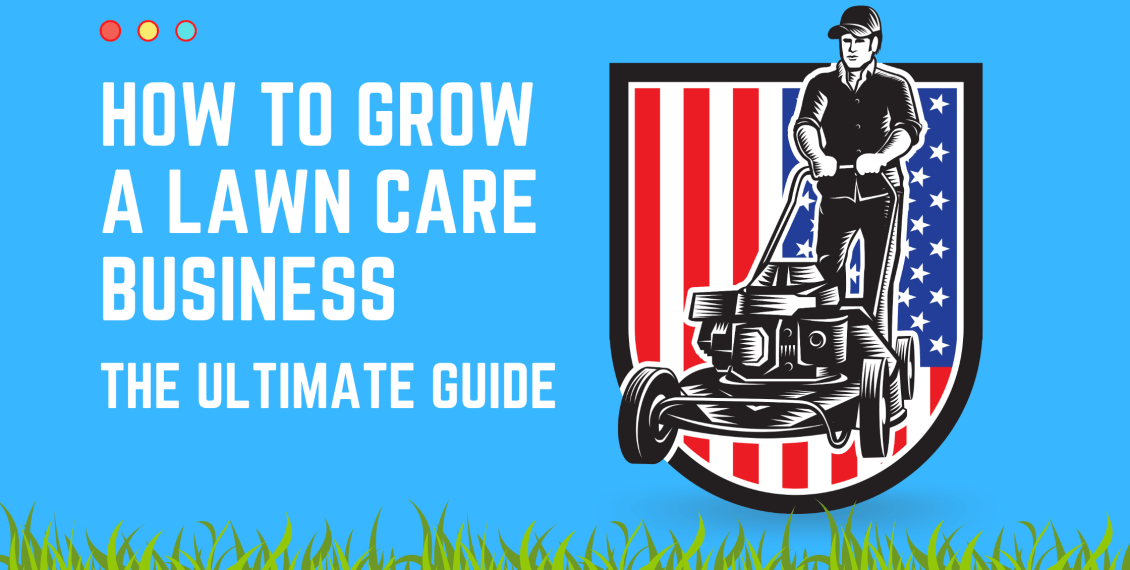More...
What's the secret to growing a lawn care business?
You probably know some lawn care businesses that are just scraping by. But others have truly scaled and are making an enormous amount of money.
In fact, if we take a quick look at Bizbuysell.com, we see two lawn care companies in two entirely different regions with a profit of $700,000+ per year.
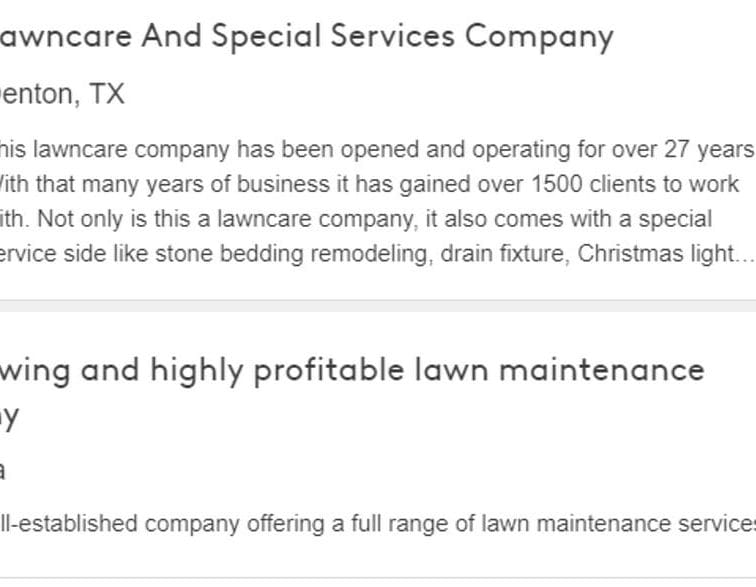
How did they do it? Do they know some business building secret that you don't?
Actually, yes. Yes, they do!
These types of businesses are more common than you think. They are located in every region of the US.
And I'm going to pull back the curtains and show you exactly how you can grow your lawn care business into an insanely profitable cash making machine.
Success Leaves Clues
For over 20 years, I've searched. Hunted. Consumed. Everything about growing businesses. Building a lawn care business is no different than most businesses.
In this guide, we will take proven strategies from the most successful lawn care businesses, other home service businesses, and entirely different industries and utilize them to help you grow your lawn care empire.
Proven strategies offer a reliable foundation for growth, as they have already been tested and shown to deliver results. Innovative ideas build upon proven strategies. They are what separate a good business from a spectacular business.
By integrating both proven strategies and innovative ideas, you can maximize your growth potential, increase profitability, and ensure the long-term success of your lawn care business.
This holistic approach enables you to capitalize on the strengths of traditional methods while continually adapting to the dynamic landscape of the industry.
Let's dive right into the details.
Customer Targeting
Whose grass do you want to cut? It's a bigger question than you think.
Look, this is one of the most overlooked steps lawn care business owners make. They go too broad.
"Anyone with grass!" they may say.
No, you don't want anyone with grass.
You want good customers. No, great customers! And I'll show you. Just keep reading.

Targeting the right customer is huge.
You want to target customers with the following attributes:
You want to find neighborhoods with a high density of high household income.
How do we find these neighborhoods? There are literally dozens of ways, but here is a very quick free way that I love:
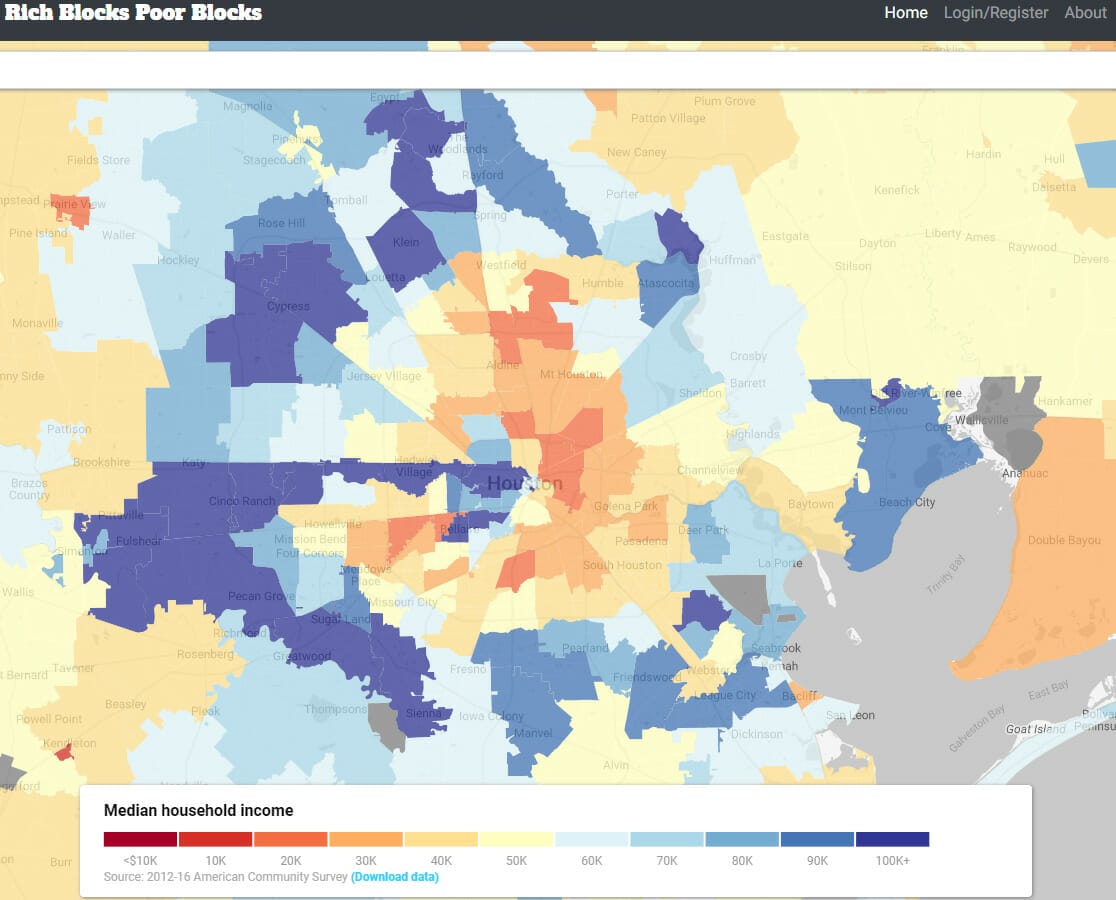
Rich Blocks Poor Blocks is an interactive map that allows you to quickly see household income data on a local level.
In the above example, we look at Houston. I immediately see a large high-income area (purple) in west Houston, in the Cinco Ranch area.
Zooming in on the map, you get a great idea of the exact neighborhoods you would want to target:
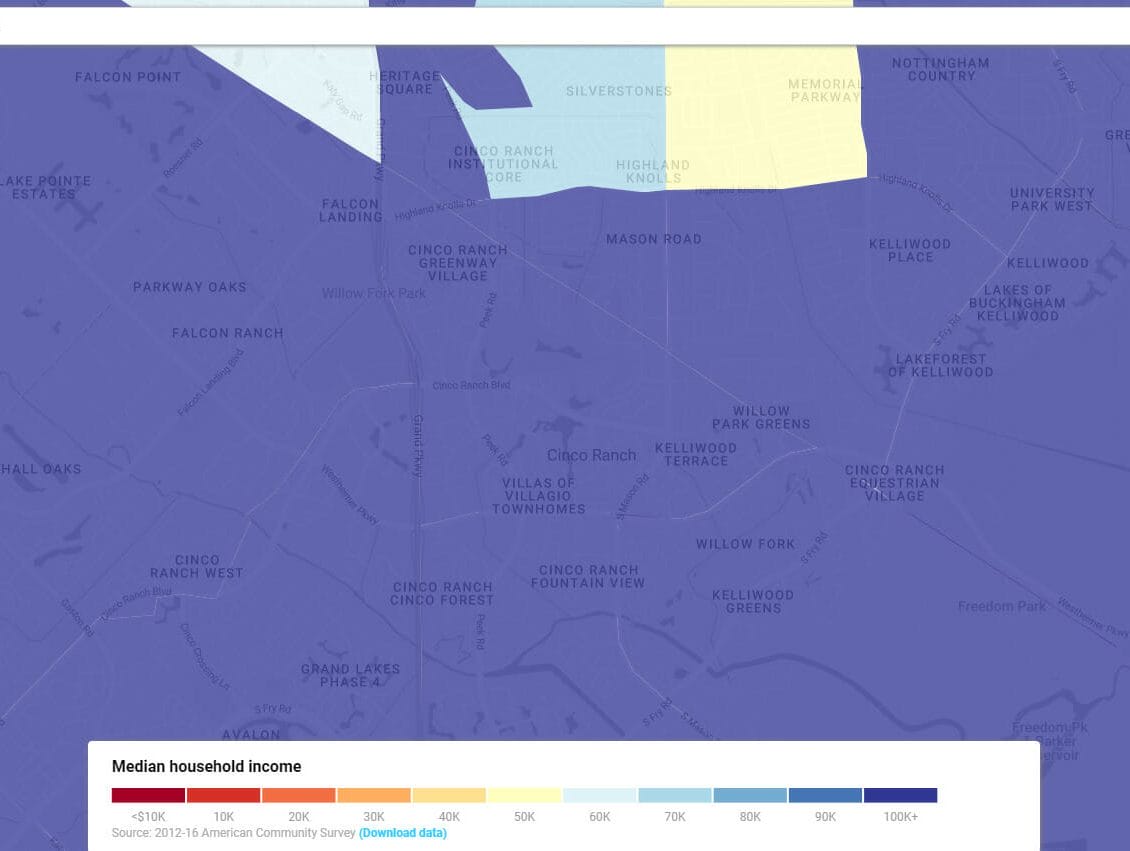
By targeting these customers, you will have a higher chance to close and will not waste money marketing to households who cannot afford your services.
Define Your Target Market
Determining your target lawn care customer is crucial for several reasons:
- Focused marketing efforts: By understanding your target customer, you can create tailored marketing messages and strategies that resonate with them. This results in more efficient use of marketing resources and higher conversion rates.
- Better service delivery: Knowing your target market helps you customize your service offerings to meet their specific needs and preferences, increasing customer satisfaction and loyalty.
- Competitive advantage: Identifying your niche allows you to differentiate your lawn care business from competitors, carve out a unique selling proposition, and become an expert in that specific market segment.
- Resource allocation: A well-defined target market enables you to allocate resources more effectively, focusing on the most lucrative customer segments and avoiding wasted efforts on less profitable ones.
Work to understand the needs and wants of your particular client base.
Unforgettable Offers
If you are going to spend time and money trying to acquire a customer, make sure your offers are so good that it would be stupid to say no.
You shouldn't be shooting for awareness. That is wasted effort.
You should be aiming to get customers to trial your services and do such a damn good job they never want to leave.
Below, we'll talk about creating Unforgettable Offers.

At least twice a week, someone drops off a poorly printed flyer that looks like it was designed in the 1980's, or just a simple business card.
While I admire their hustle, I know they are leaving so much business on the table.
Here is an example of one of the better ones I've recently had dropped on my doorstep.
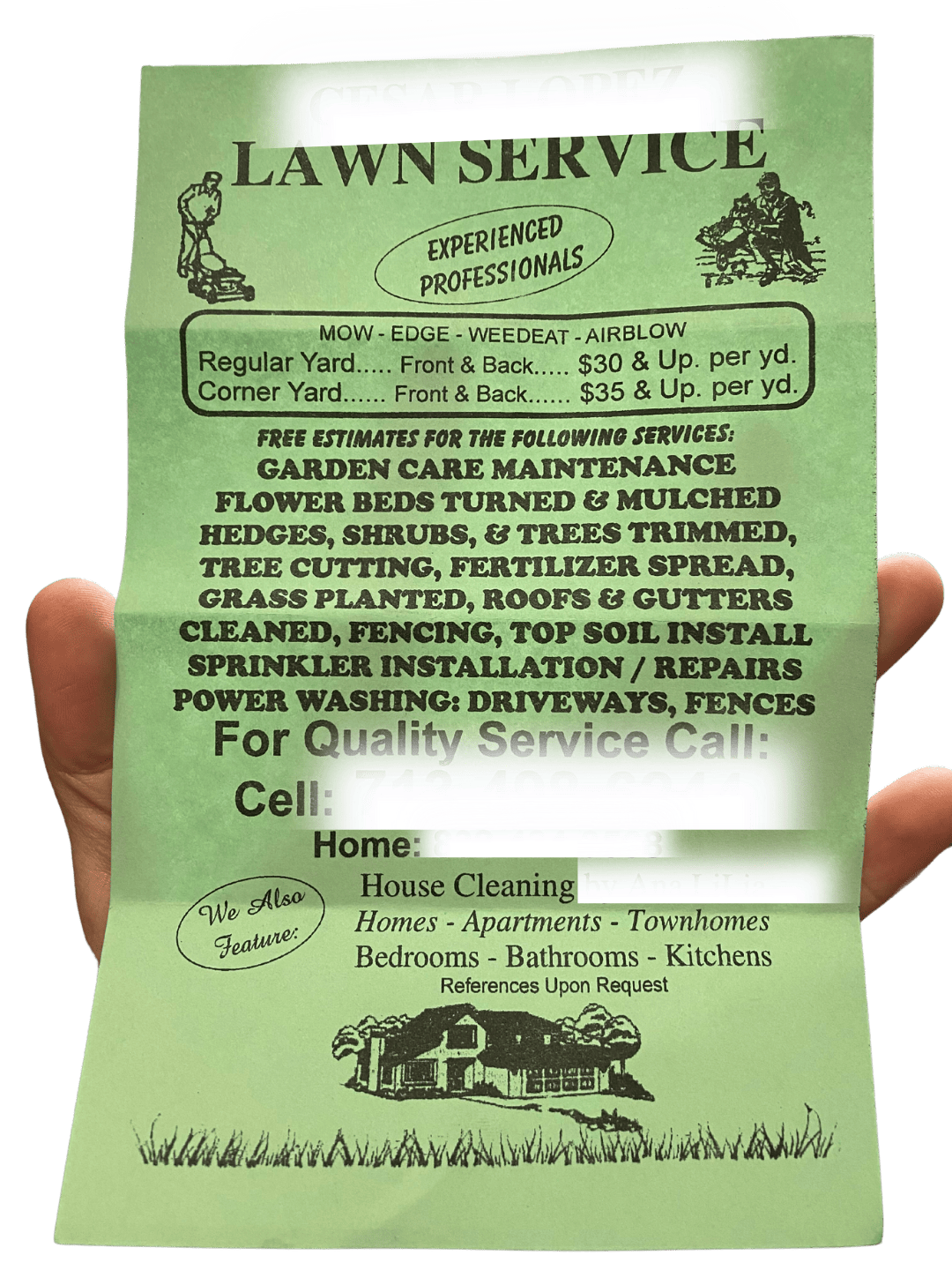
These flyers do drive awareness, and these companies may get a few calls. But more than 95% are thrown directly in the trash except for weirdos like me who collect them.
Now, if we've learned anything from internet-based businesses or direct response advertising, we know the power of a great offer and a good call-to-action or CTA.
You need to incorporate an offer so good it can't be refused and a call-to-action to ensure more clients respond.
Your offer will be driven by the services you provide.
Here are a few examples:
The idea of this offer is not to make a huge profit on the first sale. It is to get the client into your system so that you can sell over and over again.
But if you are a savvy marketer, and you are willing to test offers, you can do both with a little trial and error.
With the right offer, you'll get a much higher conversion rate and all your marketing will become more effective.
Use your "Unforgettable Offer" everywhere: your website. your marketing materials, and your ads.
Direct response marketing is still effective when done right. It can drive measurable results for lawn care businesses by eliciting immediate responses from potential customers.
Here's how a lawn care business can best implement direct response marketing:
- Craft a compelling offer: Create a strong, time-sensitive offer that incentivizes potential customers to take action. This could be a limited-time discount, a free consultation, or a special package deal.
- Target the right audience: Focus on the people most likely to need and value your services. Use customer data and market research to identify your target market, and tailor your message to address their specific needs and pain points.
- Choose appropriate marketing channels: Use channels that enable you to reach your target audience effectively, such as direct mail, flyers, door hangers, email marketing, social media advertising, or online search ads.
- Create clear, persuasive messaging: Craft a compelling message that highlights the benefits of your services, addresses potential objections, and includes a strong call-to-action (CTA) encouraging recipients to take the desired action.
- Personalize your communication: Whenever possible, use personalization to make your message more relevant and engaging. Address recipients by name or address, show a photo of their lawn, refer to their specific lawn care needs, or use local references to establish a connection. TruGreen left me a flyer with the specific issues my lawn was having and the marked the services they could offer to fix it.
- Test and optimize: Monitor the performance of your direct response campaigns and test different variables, such as headlines, offers, or targeting, to improve response rates and achieve better results.
- Track and measure results: Use tracking methods, like unique phone numbers or promotional codes, to measure the success of your campaigns. This helps you gauge the return on investment (ROI) and make data-driven decisions to optimize your marketing efforts.
Exceptional Service Delivery
Providing exceptional lawn care service is the bedrock of a scalable growing business.
Your main objective is to increase customer lifetime value, the length of how long each customer stays with your company's services.
Providing a higher level of service will increase customer satisfaction, keep customers for longer, and enhance profitability.

Delivering exceptional work helps differentiate your business from competitors and positions your company as a leader in the area.
Plus, you'll get several other benefits:
A customer complains?
Other clients will stick up for you because of your positive reputation. If you provide excellent service 99% of the time, your clients will chalk it up to a bad day and give you a second chance.
Do you truly want to maximize the amount of money you can make?
Exceptional service delivery will get you there. Of course! The longer the client utilizes your services, the higher your customer lifetime value and the less you have to spend on client acquisition.
How do You Provide the Best Lawn Care Service?
Providing great service relies on two elements. Both are equally important.
- The first is the client facing element.
- The second is the operational element.
Next, we'll describe both of these elements.
The Client Facing Element | Great Communication & Service
This is how you are perceived, how you communicate, and how you treat your client.
Sometimes perception is just as or more important than the quality of work.
If two companies are providing the exact same quality of work, the one that communicates better will be perceived as the best company.
- Communicate effectively: Maintain open and clear communication with customers throughout the service process. Keep them informed about project progress, address their concerns, and be responsive to their inquiries.
- Hire and train the right team: Employ skilled, professional, and customer-oriented team members. Invest in ongoing training to keep their skills sharp and help them stay up-to-date with industry best practices.
- Implement quality control measures: Establish quality standards for your services and regularly assess your team's performance to ensure they meet these benchmarks. Use customer feedback to identify areas for improvement.
- Be reliable and punctual: Show up on time for scheduled appointments and complete projects within the agreed-upon timeframe. Being reliable and punctual demonstrates respect for your customers' time and builds trust. In the event of a rain-out or delay, it is important to communicate reschedule and communicate with the client.
- Go the extra mile: Exceed customer expectations by paying attention to detail, offering personalized service, and proactively solving problems before they escalate.
- Follow up: After completing a job, follow up with customers to ensure they are satisfied with the service and address any concerns promptly. This demonstrates your commitment to their satisfaction and helps build long-term relationships.
By focusing on these steps, you can ensure that your lawn care business consistently delivers exceptional service, fostering customer satisfaction, loyalty, and ultimately, business growth.

The Operational Element | Optimize crew productivity
This is how your team can provide the best service to your clients.
Optimizing crew productivity is essential for a lawn care business to maximize profits and deliver exceptional service. Here are some strategies to enhance crew productivity:
- Route optimization: Plan efficient routes to minimize travel time between jobs, reducing fuel costs and allowing crews to service more clients in a day.
- Skill-based team formation: Assign tasks based on individual crew members' skills and expertise, ensuring each person is working on tasks they can complete quickly and effectively.
- Set clear expectations: Clearly communicate job requirements, performance expectations, and deadlines to crew members, ensuring they understand what needs to be accomplished and by when.
- Provide proper training: Invest in ongoing training and development for your crews, enabling them to stay current with industry best practices and work more efficiently.
- Equip crews with the right tools: Supply crews with high-quality, well-maintained equipment and tools to help them perform tasks faster and more effectively.
- Leverage technology: Utilize software and apps to streamline communication, scheduling, route planning, and time tracking, minimizing downtime and increasing crew efficiency.
- Incentivize productivity: Implement performance-based incentives, like bonuses or rewards, to encourage crews to work efficiently and maintain high standards.
- Monitor performance: Regularly assess crew performance by tracking productivity metrics, such as jobs completed per day, time spent on tasks, or customer satisfaction ratings. Use this data to identify areas for improvement and provide constructive feedback.
- Foster a positive work culture: Encourage open communication, teamwork, and a strong work ethic among crew members. A positive work environment can boost morale and improve overall productivity.
- Schedule regular maintenance: Implement a routine maintenance schedule for equipment and vehicles to reduce downtime caused by breakdowns and ensure your crews always have reliable tools to work with.
By following these strategies, a lawn care business can optimize crew productivity, leading to increased customer satisfaction, more efficient operations, and higher profits.
Density Overdrive
Customer density is one of the biggest profitability levers in lawn care services.
Fuel and travel time are a huge profitability killer.
Go all-in on identifying the densest / largest high net worth neighborhoods and concentrate all your efforts on dominating neighborhood by neighborhood for route density.

I actually learned about density while visiting my grandpa. He lived on a cul-de-sac of 4 houses.
The lawn crew pulled up right as we were getting out of the car. They parked right in the middle of the cul-de-sac, and the team fanned out.
2 men on mowers, several with weed eaters, and a guy with a blower right behind them. They finished 4 yards in maybe 30 minutes. I remember being amazed, even as a teenager.
Now, imagine they had to drive 15 minutes to the next house instead of each house being next door. That is an hour lost. Efficiency is your best friend.
So, how do we get more density?
Targeted Lawn Care Mailers & Door Hangers
It is hard to beat the simplicity of mailers and door hangers.
Coupled with an "Unforgettable Offer" that clients just can't refuse, you can increase the effectiveness of this method tremendously.
But since we are trying to dominate the neighborhood, you're not going to just do it once.
You are going to send them all the fricking time.
Ok, 15,000 may be a bit much, but you get the point.
Here's some examples:
- Once a month - one for each season and service offered.
- Got a new customer - you are going to tell the neighbors
- Neighborhood has chinch bugs - send a mailer
- Heatwave - send mailer
- Freeze - send mailer
- Sponsored a local baseball team - send a mailer
- Offering a new service - yep, send it
- Fertilization time - send a mailer
The point is to always be top of mind for your target neighborhoods. We want density.
Lawn Care Referral Programs
Does every one of your clients bring in at least 1 or more clients into your business? If not, you are missing out.
Lawn care businesses thrive on local, community-based clientele. This is why referral programs, which leverage the power of word-of-mouth recommendations, are one of the most effective strategies for growth.
Let's look at the math.
Lawn Care Referral System Business growth
Let's start with the premise that the average cost to acquire a new customer through traditional marketing channels is around $100-$150. This includes costs associated with advertising, promotions, and time spent on sales efforts.
Now, let's imagine you are running a lawn care business where the average customer spends $50 per month, and stays with your company for an average of 3 years (36 months). That's a total of $1800 in revenue per customer over their lifetime with your company.
Let's now consider a referral program where you give a $50 credit to both the existing customer who refers a new client and to the new client they referred.
If an existing customer refers a new client who signs up for your service, it costs you $100 in credits ($50 to the referring customer, $50 to the new customer). However, if the new customer stays for the average of 3 years (36 months), you will earn $1700 ($1800 - $100) in total revenue from them.
So, the cost of acquisition for a new customer via referral is only $100, lower than the $100-$150 average cost through traditional marketing and is far easier. Plus, this doesn't take into account the added benefit of strengthening your relationship with the existing customer who made the referral, potentially increasing their own loyalty and lifetime value.
Studies have shown that referred customers often prove to be more loyal and profitable in the long run, implying the lifetime value will be even higher for referred customers.
So, while there is an upfront cost to the referral credit, the long-term gain from the added revenue from the new customer outweighs this initial expense, making the referral system a profitable venture.
Once your referral system is in place, it is practically on autopilot making for fast and easy client acquisition.
Sounds good, right? How do you build a referral system? I'll show you.
- Step 1 - Set clear objectives: Determine the goals of your referral program, such as acquiring new customers, increasing revenue, or improving customer retention.
- Step 2 - Offer attractive incentives: Provide meaningful incentives for both the referrer and the referred customer. This could include discounts, free services, or gift cards. Ensure the rewards are valuable enough to motivate customers to make referrals.
- Step 3 - Simplify the referral process: Make it easy for customers to refer your services. Provide them with a simple way to share referral links or codes, such as through email, social media, or a dedicated referral platform.
- Step 4 - Promote the program: Communicate the benefits of your referral program to your customers through various channels, including email newsletters, social media posts, and in-person interactions. Consistently remind customers about the program to keep it top of mind.
- Step 5 - Track and measure success: Monitor the performance of your referral program by tracking key metrics like the number of referrals, conversion rates, and revenue generated from referrals. Use this data to optimize and improve the program over time.
- Step 6 - Personalize the experience: Whenever possible, personalize the referral experience by addressing customers by name and acknowledging their previous interactions with your company. This helps to build trust and strengthen relationships.
- Step 7 - Show appreciation: Express gratitude to customers who make referrals, either through personalized thank-you messages or public recognition on social media. This encourages continued participation in the program and fosters customer loyalty.
- Step 8 - Train your team: Ensure your staff is well-versed in the referral program and can effectively communicate its benefits to customers. Encourage them to actively promote the program during customer interactions.
By implementing these steps, a lawn care company can develop an awesome referral program that drives new business, fosters customer loyalty, and contributes to long-term growth.
Now, we understand referrals are probably the best bang for your marketing buck. You know what is better than a referral? A referral to your client's next door neighbor. Let me introduce you to the Good Neighbor Discount.
The Good Neighbor Discount
How do you supercharge your referral program? Let me introduce the Good Neighbor Discount.
The denser your client base gets, the more profitable your company becomes.
It would make financial sense to provide a discount to neighbors to incentivize them to utilize your services because it will skyrocket your profits.
Let's illustrate with an example. This one takes a bit of math but is well worth it.
Good Neighbor Discount Example
Scenario 1 - Standard Job with Normal Travel
Here, a crew can theoretically complete 12 jobs per day (10 hours / (40 mins work + 10 mins travel) per job):
Every client is estimated to be 10 mins from each other to simulate a normal lawn care route.
- Work cost per job: 0.67 hours * 3 crew members * $15/hour = $30
- Travel cost per job: 10 minutes * 3 crew members * $15/hour = $7.5
- Total cost per job: $30 + $7.5 = $37.5
- Revenue per job: $50
- Profit per job: $50 - $37.5 = $12.5
Combined daily profit for Scenario 1: $12.5/job * 12 jobs = $150
Scenario 2 - Good Neighbor Discount I
Six groups of two properties are next door; the remaining jobs are 10 minutes apart.
For the twelve next-door jobs, let's apply a 5% discount for the first neighbor in each pair:
- Revenue per job: $50 - $50 * 5% = $47.50
- Total cost per job: $30
- Profit per job: $47.50 - $30 = $17.50
- Total profit for these 12 jobs: $17.50/job * 12 jobs = $210
Because of reduced travel time, the team can complete one more job:
- Total cost for the extra job: $37.5
- Profit for the extra job: $12.5
- Total profit for the extra job: $12.5/job * 1 job = $12.5
Combined daily profit for Scenario 2: $210 + $12.5 = $222.50
Scenario 3 - Good Neighbor Discount II
Density overdrive accomplished. All properties are next door.
All jobs are next door to each other, so let's assume that you're able to offer a graduated discount of up to 15% off:
- Revenue per job: $50 - $50 * 15% = $42.50
- Total cost per job: $30
- Profit per job: $42.50 - $30 = $12.50
- Daily profit: $12.5/job * 12 jobs = $150
Because of reduced travel time, the team can complete two more jobs:
- Total cost for the extra jobs: $37.5 * 2 = $75
- Profit for the extra jobs: $12.5 * 2 = $25
- Total profit for the extra jobs: $25
Combined daily profit for Scenario 3: $150 + $25 = $175
In Scenario 1, you make a nice profit of $150 per day.
In Scenario 2, the Good Neighbor Discount strategy kicks in, and the reduction in travel time helps your profit shoot up to $222.50 per day. Whoo hoo!
But something weird happens in scenario 3. Profit reduces to $175 because of the heavy discounting. Does this mean the strategy isn't working?
Not at all.
In reality, the likelihood of you getting every house on a single street is very slim. Some people like to cut their own grass. Some homeowners have a preferred company and will not switch, and some are going to go for the cheapest fly-by-night lawn service company they can find (not you).
So, the result will most likely be pockets of homes next to each other putting you squarely in the Scenario 2, the maximized profitability bucket,
Partner, Trade, or Buy Routes
Have you noticed any other lawn care companies operating in YOUR neighborhood? What gives?
This could be the perfect opportunity to buy density. What do I mean?
I mean you can buy, trade, or even partner for your most preferred routes:
- Buying Lawn Care Routes: This involves purchasing an existing lawn care route from another company or individual. The key benefit of this approach is that you're buying an established customer base, reducing the time and effort needed to build one from scratch. However, the cost can be significant. Typically, lawn care routes are valued based on a multiple of their annual revenue or profit. For example, if a route generates $50,000 in annual revenue, it might be priced at 1-2 times that amount, or $50,000 to $100,000. The exact multiple depends on factors such as the route's growth potential, the profitability of its contracts, and the stability of its customer base.
- Trading Lawn Care Routes: This involves swapping routes with another company. This can be a cost-effective way to optimize your operations, particularly if you have routes that are geographically scattered or inefficient. By swapping routes, you might be able to consolidate your operations and reduce travel time and costs. The economics of trading routes depend on the relative value of the routes being swapped. Ideally, both companies should benefit equally from the trade.
- Partnering for Lawn Care Routes: This involves forming a partnership or joint venture with another company to share or co-manage lawn care routes. This can be a way to grow your business without having to buy routes outright. The economics of this arrangement depend on the terms of the partnership. For example, you might agree to split revenues and costs 50/50, or you might have a different arrangement based on each partner's contribution to the business.

There are several reasons a company might want to sell their routes.
- Business Restructuring: They may be looking to pivot their business model or focus on a different aspect of the business. Selling routes can free up resources to support this shift.
- Geographic Optimization: If a company has a route that is far from its main service area, it may be logistically challenging and costly to service. Selling such a route could improve efficiency.
- Exit Strategy: The owner of the company may be planning to retire or move on to a different business venture. Selling their routes is a way to monetize their investment.
- Financial Reasons: If the company is in financial distress, they might sell routes to raise capital quickly.
- Underperforming Routes: If a route is not profitable, it might make financial sense to sell it rather than trying to turn it around.
- Consolidation: The company may be looking to streamline their operations and focus on their most profitable routes. Selling less profitable or more difficult to manage routes can help achieve this.
The good news is that their trash can be your treasure, and a fast way to grow density.
Maximize Customer Lifetime Value
How long a client remains a client is one of the most important metrics of a successful lawn care business.
Are you doing all that you can to provide top notch customer service?
Good. Then, let's look at how to increase your Customer Lifetime Value in this next section.

The number one thing you can do to extend customer lifetime value (or CLV) is to provide top notch service.
If you can't do the basics, I can't help you grow because you'll lose customers faster than you gain them. Not good,
You should be able to provide the following:
- Reliability and Consistency: Clients should be able to trust that the services will be carried out regularly, as per the agreed schedule, and that the quality of work will be consistently high. Inconsistency can lead to dissatisfaction and lost business.
- Communication: Clear, open, and timely communication is essential. This includes listening to and understanding customer needs, informing them about any issues, changes, or delays, and promptly responding to queries and complaints.
- Professionalism: Crew members should be trained to behave professionally at all times. This includes being punctual, treating customers respectfully, wearing proper uniforms, and keeping equipment and vehicles clean and well-maintained.
- Expertise and Quality: The team should be trained and knowledgeable enough to deliver quality services, offer expert advice, and answer customer questions effectively. They should be able to address a wide range of lawn care issues, from basic mowing and trimming to more specialized services like pest control, fertilization, and aeration.
- Responsiveness: A lawn care company should respond quickly to customer inquiries, concerns, or complaints. Promptly addressing problems not only helps retain customers but also boosts the company's reputation.
- Flexibility: Every lawn and client is unique. Offering flexible and personalized services to suit each client's specific needs and preferences can greatly enhance customer satisfaction.
- Value for Money: Customers should feel that they're getting good value for their money. This doesn't necessarily mean being the cheapest, but rather delivering high-quality services at a fair and competitive price.
- Transparency: Be upfront about pricing, services included, and any additional fees. This avoids any surprises for the customer and builds trust.
- Safety: Prioritize safety, both of your employees and your customers. Ensure all equipment is used and maintained correctly, and that employees are trained in safety procedures.
Implement Upselling & Cross-Selling Strategies
Upselling and cross-selling your current customer base is a gold mine. Some people have told me that this feels spammy, but it could not be further from the truth!

First, providing additional services that your client already needs is a huge benefit to them. They already trust you, they know you do good work, that you are honest, and more importantly, they do not have to go out into the market and find someone who could take advantage of them or provide poor-quality work.
Second, this can be one of the fastest ways to grow your business within your current client base without having to go out and find new clients.
What types of additional services can you offer?
- Service upgrades: Offer premium versions of your existing services (e.g., a more comprehensive lawn treatment or a higher-quality fertilizer) and explain the benefits of upgrading.
- Seasonal services: Promote seasonal services like aeration, fertilizer application, dethatching, or winterizing at the appropriate times of the year, helping customers maintain their lawns throughout the changing seasons.
- Landscape enhancements: Suggest landscape improvements such as flower bed installation, mulching, or tree and shrub planting to enhance the overall aesthetics of a customer's property.
- Maintenance packages: Create bundled maintenance packages that include multiple services at a discounted rate, encouraging customers to commit to long-term contracts and providing them with an all-in-one solution.
- Complementary services: Cross-sell services that complement your core offerings, like irrigation system maintenance, outdoor lighting installation, or pest control, to provide a more comprehensive lawn care experience.
Ideally, you would expand your offerings to include these additional services over time.
However, you could partner with vetted subcontractors to do this additional work for a portion of the proceeds.
Offering these additional services and upgrades will provide tremendous benefits to your business.

Cross selling and upselling customers can be hard if you're not the salesy type. So, I've come up with a dead simple way that anyone can do it called the "Property Check".
Up Your Customer Lifetime Value with the Property Check
The Property Check is a simple checklist that your crews can use to find common lawn, garden, tree, and other property issues.
These issues, once identified, are opportunities for an easy offer and upsell.
Each lawn crew will have a checklist for each property where they quickly check for problems. Things like:
- Brown spots, bugs, fungus, etc.
- Ugly gardens and weeds
- Winterization needs
- Tree trimming needs
- Etc.
Here is a quick example. Note, I threw this together quickly, so this can be greatly improved upon.
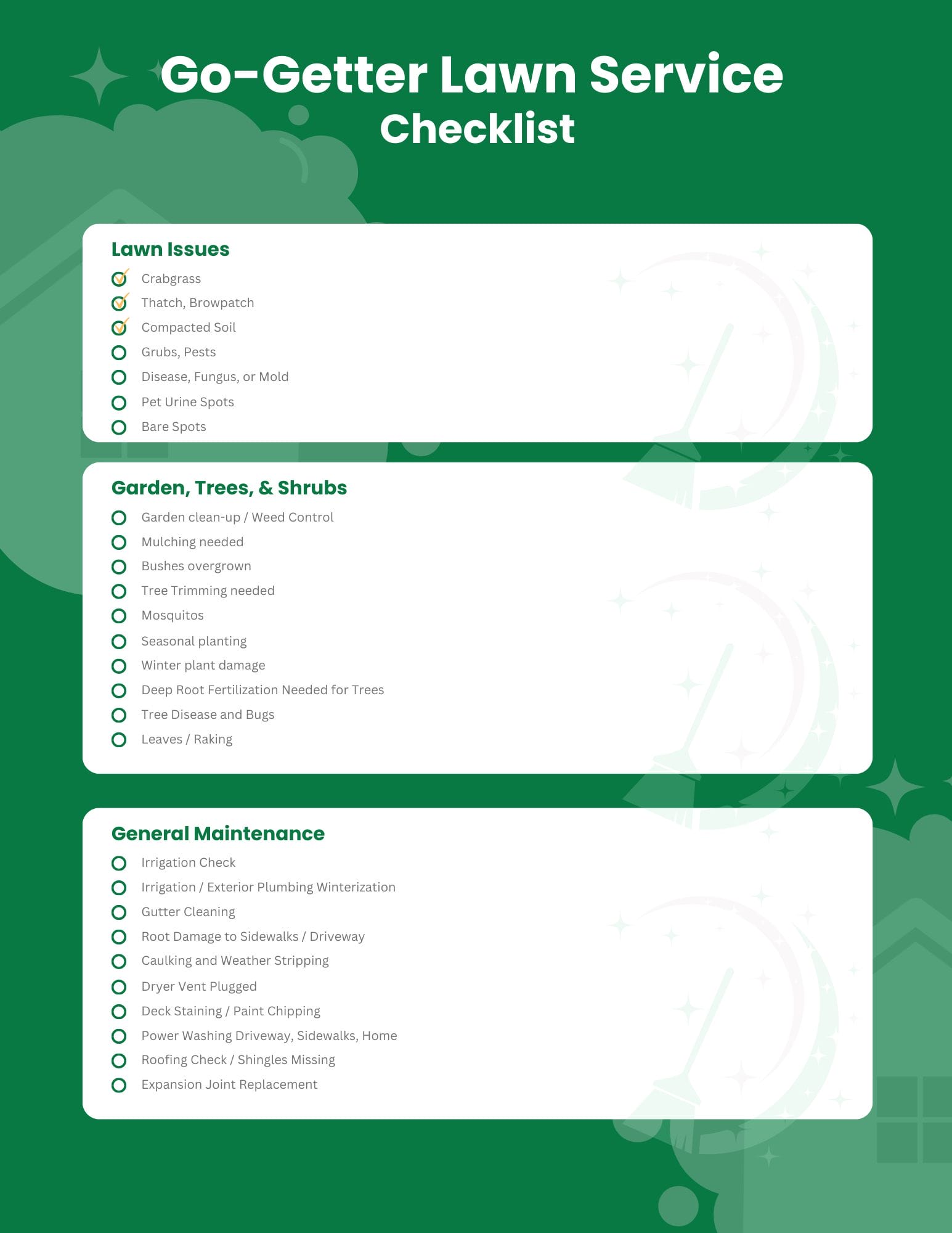
We'd use this for 2 reasons.
- To communicate useful info with the client regularly and show you care.
- To find opportunities for upsells/cross-sells
The beauty of this approach is that instead of coming across as a greedy salesman, you sound more like a concerned, caring, and helpful friend who can both point out a problem and offer a solution to fix it.
This little technique is a gold mine.
You'll need to determine how you follow-up once an issue is identified.
The sequence should be:
- Identify the Issue
- Explain the issue (Educate)
- Explain how it can be fixed
- Offer to fix it or refer a trusted partner who can
You can do this in-person, by mailer, a flyer on the next service, or with a phone call.
Communicate with Your Lawn Care Clients Regularly
A communication plan should be developed for regular, helpful guidance.
The goal of communication is education.
Communication should be specifically tailored to the local climate, trends, season, etc.

Communication should be split between e-mail, mailers, phone calls,, or notes left behind after each service.
At a minimum, develop a monthly cadence. That is only 12 communications. Here is a sample, but change it up to match your climate zone:
- January - Protecting Plants from Frost: Offer tips on how to protect sensitive plants from occasional frost, including the use of covers and strategic watering.
- February - Pre-Spring Soil Preparation: Discuss the importance of soil testing and how to properly prepare soil for spring plantings.
- March - Spring Fertilization: Explain the benefits of fertilizing in early spring to support new growth and offer product recommendations.
- April - Pest and Disease Prevention: Share information about common local pests and diseases, and how to prevent them as temperatures warm.
- May - Irrigation Tips: With the onset of warmer weather, provide tips on efficient watering techniques to maintain lawn health while conserving water.
- June - Heat Tolerance: Discuss plant selection and lawn care practices for the hot summer.
- July - Mulching and Water Conservation: Highlight the benefits of mulching for water conservation and soil health during the hot, dry summer months.
- August - Tree and Shrub Care: Provide advice on caring for trees and shrubs during the summer, including signs of heat stress and proper watering techniques.
- September - Fall Lawn Care: Discuss transitioning to fall lawn care, including adjusting watering schedules and preparing for fall fertilization.
- October - Winterizing Your Lawn: Provide tips on how to prepare a lawn for the upcoming winter, including aeration, seeding, and fertilization.
- November - Pre-Winter Plant Care: Discuss how to care for and protect plants during the cooler winter months.
- December - Planning for the New Year: Review lawn care tips from the past year and provide a checklist for planning the next year's lawn care.
Besides being educational, also include an offer to help them with that month's theme - whether through your services or a partner.
All Lawn Care Companies Should Implement a Subscription Based Pricing Model

Subscription-based pricing models are fantastic for lawn care companies for several reasons:
- Predictable revenue: Subscriptions provide a steady stream of recurring revenue, making it easier for lawn care companies to forecast and plan their finances.
- Improved cash flow: Regular payments from subscription customers help maintain a consistent cash flow, allowing businesses to cover expenses and invest in growth more effectively.
- Customer retention: Subscription models encourage long-term relationships with customers, leading to increased loyalty and reduced customer churn.
- Better resource planning: Knowing how many customers are subscribed to a service allows for better scheduling and resource allocation, reducing wasted time and maximizing productivity.
- Cross-selling and upselling opportunities: Subscriptions provide a regular touchpoint with customers, presenting opportunities to offer additional services or upgrades, which can further increase revenue.
- Cost savings for customers: Subscription pricing often offers customers better value compared to one-off services, making it more attractive and easier for them to commit to long-term contracts.
- Easier marketing: Subscription services simplify marketing efforts by focusing on a single core offering, making it easier for potential customers to understand and compare with competitors.
- Customer convenience: Subscriptions eliminate the need for customers to schedule individual services repeatedly, providing them with a hassle-free and convenient lawn care solution.
By adopting a subscription-based pricing model, lawn care companies can enjoy increased revenue stability, improved customer retention, and more efficient business operations.
Maximize Average Order Value
Put another way, maximize your helpfulness to your clients. Provide them with everything they need for their yard from a company they already trust.
This just also happens to maximize profitability for you and your company.
How do we do it? I'll show you in this next section.
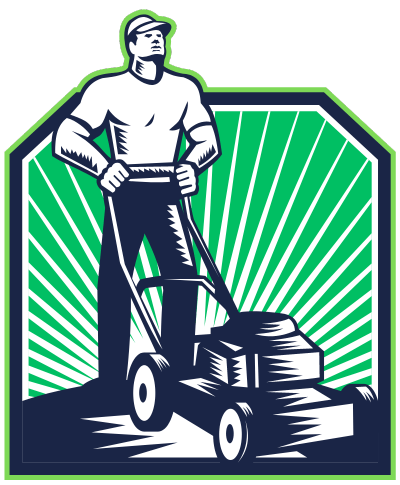
The Average Order Value (AOV) is a metric often used in ecommerce and retail that measures the average total of each order placed with a company over a certain period of time. It's calculated by dividing the total revenue by the number of orders.
For lawn care companies, the AOV would typically be calculated by dividing the total revenue earned from services (such as mowing, fertilizing, aerating, etc.) by the total number of orders or jobs completed.
AOV is important for a few reasons:
- Profitability: A higher AOV often means higher profits per transaction. If a lawn care company can increase the average order value, it can make more money from each transaction, which helps boost overall profitability.
- Customer Value: Understanding the AOV can help a company understand its customer base better. If most customers are only purchasing lower-cost services, the company might need to do more to promote its higher-cost services or upsell additional services.
- Marketing and Sales Strategy: AOV can inform a company's sales and marketing strategies. For example, if the AOV is lower than desired, a company could implement strategies to encourage customers to spend more, such as package deals or loyalty programs.
- Resource Allocation: Knowing your AOV can also help in planning resources and scheduling. For instance, if a company knows that the AOV from customers in a certain area is high, it may allocate more resources or give priority to that area.
- Performance Tracking: Tracking AOV over time can help a company understand if its efforts to increase revenue per transaction are working. If AOV increases, the strategies implemented are likely effective.
There are 53 ways to increase AOV. Let's discuss a few that will really move the needle for your lawn care company.
The Lawn Care Sales Process
Sales is a process where you move clients through a pre-determined flow.
This flow is designed to provide maximum value to your clients while achieving high profitability for your company.
The sales process should be built out to maximize services rendered and can be super simple for your lawn care company:
- Start with a great offer.
- Get them on a subscription.
- Implement packages in good, better, best format
- Upsell to additional services.
Let's start with product bundling and good, better, best pricing.
One, Two Punch | Product Bundling & Good, Better, Best Pricing Strategies
We're going to take two of my favorite AOV boosters and combine them for a huge AOV boost.

Product bundles are when you bundle multiple goods or services into one package.
Good, Better, Best Pricing is a product bundling technique that utilizes psychology and value to get more clients to opt for a higher-priced tier of services.
This method utilizes three pricing tiers.
- Good Tier (low price) – the value price for customers who cannot afford your better tier but still want or need your products or services
- Better Tier (middle price) - the better tier is typically the best value for your customer and the one you want most customers to buy
- Best Tier (highest price) – your highest priced option that serves both as a price anchor for your better tier and as the best option for more discerning or enterprising customers.
Your offer should look something like this:
YardBasic
$39.99 per month
YardPro
$89.99 per month
YardZen
$139.99 per month
When you use this technique, you bundle multiple services into packages making it super easy for your clients to choose more services.
By utilizing good, better, best pricing, you'll see more clients choosing the middle option, and even some choosing the highest tier, strategically raising your AOV.
Pure awesomeness.
Upsell Again with the Property Check, Part II
We're coming back to the property check because it is a CLV and AOV boosting machine.
Use the property check to recommend services when they are needed and to smooth out seasonal periods.
- Mulch time? Offer mulch.
- Trees Ugly? Offer trimming
- Garden overgrown? Offer maintenance.
- Etc.
Every time you come to the property you have a chance of making a larger sale.
But what if you do not offer other services?
Good point. Now, here is the big secret about the Property Check that can unlock huge profits in your business.
You do not have to offer only services that you can offer. You'll build out a partner program of highly trusted companies that can do some of this work.
What if your customer checklist shows the homeowner needs a new roof, gutters, garage door, has cracks in sidewalks, or has tons of dog poop?
Your trusted partners can do this work, you'll have a referral fee that gets you a percentage of the profits. A true win-win.
Who Has Your Clients?
There is one thing I love more than finding profitable client acquisition channels.
Getting customers absolutely free through great referral partners.
Someone has your clients, and they are just begging for a company like yours to help them.

The question you have to ask yourself is, "Who has my clients?"
Really think about it.
- Who do you work with regularly?
- Where do your clients go when they need yard work done?
- When does someone need to spruce up their yard?
- What other services and products do they need to have a great yard?
Armed with this thought process, you can build an army of referral partners that will constantly refer work your way.

Here are some examples:
- Real Estate Agents & Brokers - May need to spruce up the yard prior to listing a house, or the new homeowners may need a trusted company.
- Property Management Co's - Manage tons of properties that all have lawn care needs
- Home Builders & Developers - all need yard work after the homes are built to help them sell
- Garden Centers & Nurseries - Does your local garden store offer lawn care or installation services? If not, this is a great opportunity to partner.
- Home Improvement Stores - Be the company they recommend when a DIY project becomes a can't do it myself project.
- Pest Control Companies - Every house has a pest control company. Can they be your scouts to find top clients?
- HOA's - Plenty of HOA partnership plays. Be creative.
- Outdoor Living Co's - They just built a beautiful covered porch and outdoor kitchen. Don't you think they'll want the yard to match?
- Roofers - Most roofs are changed when someone is selling or has just bought a house. Both are opportunities for yard work.
- And tons more.- Think outside the box!
A lot of these opportunities will be for one-off projects. But now that you have a top notch sales process, I'm sure you'll be turning these one-offs into subscriptions in no time!
Network with Complementary Businesses
A lawn care company can network with complementary businesses to create mutually beneficial partnerships, increase referral opportunities, and broaden their client base. Here are some strategies to network with complementary businesses:
- Identify potential partners: Determine which types of businesses share similar target markets and can complement your lawn care services. Some examples include landscapers, garden centers, tree care services, pest control companies, irrigation specialists, property management firms, and real estate agents.
- Attend industry events: Participate in local networking events, trade shows, and industry conferences to meet potential partners and establish connections. Be prepared to discuss your services, the benefits of partnering, and how you can support each other's businesses.
- Leverage social media: Connect with complementary businesses on social media platforms like LinkedIn, Facebook, or Instagram. Engage with their content, share their posts, and introduce yourself through direct messages to start building relationships.
- Offer co-marketing opportunities: Propose joint marketing initiatives, such as co-branded promotions, shared advertising, or content collaborations. This allows both businesses to benefit from each other's audience and reach new customers.
- Create referral agreements: Establish formal referral arrangements with complementary businesses, where each party agrees to refer customers to the other in exchange for a commission or other incentives.
- Host or participate in local workshops or events: Collaborate with complementary businesses to organize educational workshops or community events that showcase your combined expertise. This helps to position both companies as authorities in the industry and builds trust with potential customers.
- Provide testimonials or case studies: Share success stories or testimonials about how your partnership has benefited customers. This adds credibility to both businesses and encourages more customers to use your combined services.
By targeting complementary businesses and employing these networking strategies, a lawn care company can create valuable partnerships, increase referral opportunities, and ultimately, achieve greater success.
Lawn Care Branding & Marketing
Now that the machine is in place, let's talk about branding and marketing for your lawn care company.
With a maximized AOV & CLV, all of your marketing efforts will be exponential.
Let's turn up the volume!

Did you notice that I wrote this "How to Grow Your Lawn Care Company" guide with marketing and branding all the way at the end?
I did this for two reasons.
- Implementing the steps above will supercharge your marketing and will have a compound effect on profitability.
- Everyone writes about branding & marketing so there is already a ton of info on it elsewhere.
Let's start with branding.
Branding for Lawn Care Businesses

I've built an entire business on branding alone. Our name stood out, and customers were willing to pay many times more for our product than competing products.
That is the power of branding.
What do you want your brand to inspire?
- Trust
- Quality
- Expertise
Your company can either be just another lawn care company, or the lawn care company everyone is talking about. I'd rather be the latter.
Develop a strong brand identity
Your lawn care company can use eye-catching branding and vehicle graphics to build your business.
Our friends at Top Choice Lawn Care in Austin, utilize very clear, easy to read vehicle graphics. Their phone number and website are easy to read, and you immediately know what type of work they do. This not only goes for their trucks - their employees where professional branded work gear for a full branding experience.
A well-designed, visually appealing brand and vehicle graphics can make a significant impact on attracting potential clients and creating a memorable image. Here's why they can be successful and how to implement them effectively:
- Brand recognition: Unique, consistent branding across your vehicles, uniforms, and marketing materials help create brand recognition, making your company more memorable to potential customers.
- Mobile advertising: Vehicle graphics serve as a moving advertisement, showcasing your business to potential clients as you travel between job sites.
- Professional image: High-quality branding and vehicle graphics convey a professional image, instilling confidence in potential clients that your company provides top-notch services.
- Competitive advantage: Eye-catching branding and vehicle graphics can help set your lawn care company apart from competitors, giving you an edge in a competitive market.
Best practices for implementing eye-catching branding and vehicle graphics:
- Consistency: Ensure your branding is consistent across all channels, including your logo, color scheme, fonts, and messaging. This consistency helps reinforce your brand identity and recognition.
- Simplicity: Keep your branding and vehicle graphics simple, clean, and easy to read, focusing on your company name, logo, and essential contact information (such as phone number and website). I see too many company vehicles where the text in not readable.
- Contrast: Use contrasting colors in your vehicle graphics to make your branding stand out and be easily visible from a distance.
- Quality materials: Invest in high-quality, durable materials for your vehicle graphics to ensure they last and maintain a professional appearance.
- Regular maintenance: Keep your vehicles clean and well-maintained, as a dirty or damaged vehicle can detract from your branding efforts and professional image.
By implementing eye-catching branding and vehicle graphics, lawn care companies can create a memorable, professional image that helps attract new clients and grow their business.
The Magic of Testimonials
Leveraging testimonials and reviews can significantly impact a lawn care company's growth by building trust, credibility, and social proof. Here are some strategies for using and collecting testimonials and reviews effectively:
Using testimonials and reviews to build your business:
- Website: Feature positive testimonials and reviews prominently on your website's homepage, service pages, and dedicated testimonials page.
- Social media: Share testimonials and reviews on your company's social media channels, such as Facebook, Instagram, and Twitter, to engage with your audience and showcase your work quality.
- Email marketing: Include customer testimonials in your email newsletters or promotional emails to build trust with potential clients.
- Marketing materials: Incorporate testimonials into brochures, flyers, or other print marketing materials to demonstrate social proof to prospective customers.
- Case studies: Create detailed case studies that showcase your work, including before and after photos, and incorporate testimonials from satisfied clients.
- Online directories: Encourage customers to leave reviews on popular review websites, such as Google My Business, Yelp, or Angie's List, where potential clients are likely to search for lawn care services.

Strategies for collecting testimonials and reviews:
- Ask for feedback: Request testimonials and reviews from satisfied customers after completing a job. Make it easy for them by providing a direct link to your review platform or a simple form to complete.
- Follow up: Send a follow-up email or text message to customers a few days after the job is completed, gently reminding them to leave a review or testimonial.
- Offer incentives: Encourage customers to leave reviews by offering a small discount or reward for their time and effort, such as a coupon or entry into a raffle.
- Social media monitoring: Keep an eye on your social media channels for positive comments or mentions from customers. Reach out and ask if you can use their comments as a testimonial on your website or marketing materials.
- Surveys: Send out customer satisfaction surveys after completing jobs to gauge the quality of your service. Use positive feedback as testimonials and address any issues to improve your services.
- Video testimonials: Request video testimonials from satisfied clients, which can be even more impactful than written testimonials. Share these videos on your website, social media, and other marketing channels.
By effectively leveraging testimonials and reviews, a lawn care company can build trust with potential clients, showcase its expertise, and ultimately grow its customer base.
Marketing for Lawn Care Businesses
Marketing a lawn care company effectively requires a strategic combination of digital and traditional methods.
Here are some of the highest ROI and most effective ways to promote your lawn care business.
I've already gone over some of these, so I won't go too far into details:
Direct Mail, Door Hangers, & Flyers
Sending postcards or flyers to targeted neighborhoods can be a highly effective way to generate new leads.
Include an Unforgettable Offer to incentivize new customers and boost conversions.
Remember, this is YOUR hood. Most companies do a round of flyers once. You will do them several times a year in the same neighborhood to build density.

High Converting Website + Search Engine Optimization (SEO)

A well-optimized website can rank high in search engine results, making it easier for potential customers to find your business.
Focus on local SEO, targeting keywords that are relevant to your specific service area.
The SEO strategy is simply one of the highest ROI methods out there if it is coupled with a quality high conversion website.
Pay-Per-Click Advertising (PPC)
Platforms like Google Ads allow you to target specific geographic areas and demographics, and you only pay when someone clicks on your ad.
This can be a cost-effective way to drive traffic to your website and generate leads, especially if you are not getting organic traffic through SEO.
The secret to PPC is to implement a call to action. Hopefully, you already know you should be advertising an "unforgettable offer".

Referrals:
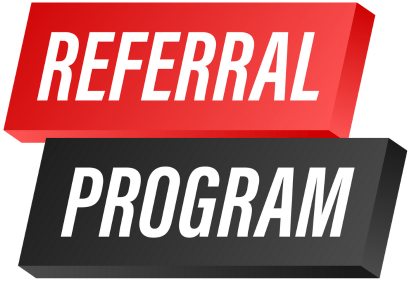
A well-designed referral program can do wonders for organic growth.
The beauty of referral programs is that once you build them, it becomes a marketing machine that requires little extra cost.
Build asking for referrals into your standard operating procedure for a steady flow of new clients and an increase in client density.
Partnerships (Who Has Your Customers?)
Partner with local businesses that offer complementary services (like landscaping or tree services) to cross-promote each other.
Find non-competing businesses and present an offer to refer business to each other. Make it a win-win.
This is another one that takes some effort to set up but will pay for a long time.

Email Marketing

Email campaigns provide one of the highest returns on investment, particularly with existing clients.
They can be used to stay top-of-mind with existing clients, send promotional offers, or share valuable content that helps position your company as an expert.
Use email marketing with your "Property Check", upsells and cross sells, and general marketing material.
Utilize them as a means to generate referrals, testimonials, and reviews on your favorite platforms.
Online Reviews and Testimonials
Encourage satisfied customers to leave reviews on platforms like Google My Business, Yelp, and Facebook.
Positive reviews can significantly boost your credibility and attract more customers.
I've seen Google My Business pages/listings drive significant revenue when done right.

Press & Media Coverage

Being featured in local newspapers, magazines, and local news can really help spread awareness of your brand.
I wrote an entire article on how to get press for your biz.
One thing I'd really push for a lawn care company is to approach your local newspaper or tv station to become the lawn care expert where you would provide seasonal updates on how their readers or viewers can best take care of their yards.
Vehicle Branding
Your vehicles are moving billboards.
Invest in professional-quality vehicle wraps that showcase your brand and include your contact information.
A few keys to vehicle branding:
- Make sure the brand is memorable. Good name, good branding, and distinctive colors.
- Make sure the text is legible. I've seen too many trucks with too much text that make them unreadable.
- Make sure your drivers are responsible. If your name is on the truck, remember, your drivers and crew are a reflection of your company and values.
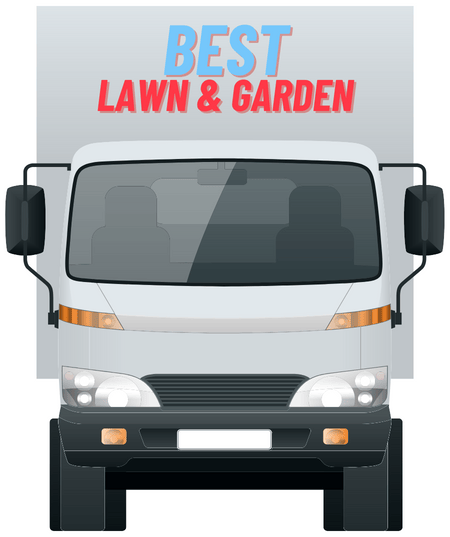
Community Engagement

Sponsor local events or a local sports team, join community organizations, or donate services to local charities.
Do your kids play baseball? Sponsor the local little league baseball league.
Join your local chamber of commerce.
Put on events. Teach a class on how to care for a lawn, gardening, or other yard maintenance.
These activities not only help you build a positive brand image but also connect you with potential customers.
Content Marketing & Social Media Marketing
I don't believe content marketing & social media are the highest ROI channels for lawn care companies which is why they are last. However, they can work if done right.
Education is important, so lawn care education can go a long way when tailored to your clients and region. Share valuable content (like blog posts or videos about lawn care tips) on your website and social media platforms. This can help establish your company as a knowledgeable industry leader and attract organic traffic.
Platforms like Facebook and Instagram allow you to engage with your local community, showcase your work, and share valuable lawn care tips. Paid social ads can also help you reach a wider audience. Before and afters work well on social media.

Profitability & Expense Management
Stay profitable and keep more of your profits.
Keeping on top of expenses and profitability is challenging when quickly growing a company.
Slow and steady is the easier path, but if you want to scale, these tips will be super important.

I wasn't planning on writing about profitability and expense management, but I realized rapid growth is often difficult for lawn care companies.
By difficult, I mean cashflow.
If you are serious about growth, I implore you to hire a good accountant and have them help you monitor and track important key metrics for your company.
Lawn Care Company Key Performance Indicators
Your accountant can help you with all the standard Key Performance Indicators (KPI) to ensure you are running a healthy business without slipping into negative territory while in growth mode.
- Revenue: This is the total amount of income generated from the provision of lawn care services. It's important to track revenue growth over time to understand how well your business is expanding.
- Gross Profit Margin: This is calculated by subtracting the cost of goods sold (COGS) from the total revenue, and then dividing the result by the total revenue. The COGS for a lawn care company includes the direct costs of providing the services, such as labor, equipment, and supplies.
- Net Profit Margin: This is calculated by subtracting all expenses (including overheads like administrative and marketing costs) from the gross profit, and then dividing the result by the total revenue. It indicates how much of each dollar of revenue is left over as profit after all costs are accounted for.
- Operating Cash Flow: This is the cash generated by the company's regular business operations. If this is consistently positive, it indicates that the company's core business is sound and capable of funding its own growth.
- Return on Investment (ROI): ROI measures the profitability of investments made in the business, such as new equipment or marketing campaigns. It's calculated by dividing the net profit from an investment by the cost of the investment.
- Customer Acquisition Cost (CAC): This is the total cost of acquiring a new customer, including advertising, salespeople's salaries, and any other related expenses. Lowering the CAC can significantly improve profitability.
- Customer Lifetime Value (CLV): This is the total revenue expected from a customer over the duration of their relationship with the company. A high CLV relative to the CAC indicates a healthy business model.
- Debt-to-Equity Ratio: This is a measure of a company's financial leverage, calculated by dividing total liabilities by shareholders' equity. It shows the extent to which the company is using debt to finance its operations.
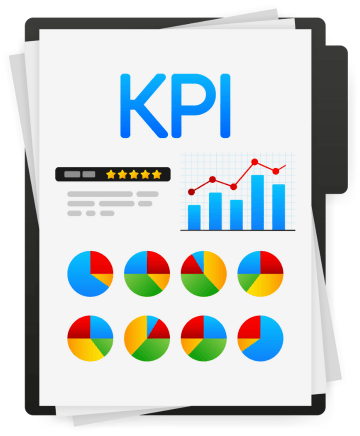
In addition to the standard KPI's that all companies should track, here are some lawn care specific KPI's that are fundamental to good lawn care financial management:
- Jobs Per Day: The number of jobs your teams are able to complete each day can provide insights into efficiency. Higher numbers typically indicate well-organized scheduling and proficient teams.
- Job Completion Rate: This KPI measures the proportion of jobs that are completed within the agreed-upon timeframe. It's a good indicator of reliability and customer satisfaction.
- Average Job Time: This KPI measures the average time it takes to complete a job. It can help identify inefficiencies and areas for potential process improvements.
- Equipment Utilization Rate: This measures how often your lawn care equipment is being used versus sitting idle. Maximizing this ratio can lead to increased productivity and profitability.
- Customer Retention Rate: In the lawn care business, maintaining long-term clients is often more cost-effective than constantly acquiring new ones. This metric measures your success at keeping clients over time.
- Upsell/Cross-sell Rate: This measures how often your team is able to sell additional services or upgrades to existing clients. Higher rates can significantly increase revenue.
- Seasonal Downtime: Lawn care is often a seasonal business. Monitoring the downtime can help in planning and optimizing the workforce and resources for maximum profitability.
- Cost Per Lawn: This KPI involves calculating all costs involved in servicing a lawn and helps determine pricing strategies, resource allocation, and profitability targets.
- Online Reviews and Ratings: Although not a traditional KPI, monitoring online reviews and ratings can provide valuable feedback on customer satisfaction and your company's reputation.
Lawn Care Company Expenses
What gets measured gets managed. Monitoring expenses is crucial for lawn care businesses to maintain profitability, control costs, and make informed financial decisions.
Monitoring expenses are even more important during growth mode. You'll be investing in new equipment, trucks and trailers, and personnel as you grow. Keeping a handle on expenses is key.
Importance of monitoring expenses:
Why is monitoring expenses so important?
- Profitability: Understanding and controlling expenses directly impacts your bottom line, ensuring your business remains profitable and sustainable.
- Budgeting: Regularly monitoring expenses allows for accurate budgeting and forecasting, helping you allocate resources more effectively.
- Cost control: Identifying areas of excessive spending or inefficiencies enables you to implement cost-saving measures and optimize resource utilization.
- Pricing: Knowing your expenses helps you price your services competitively while maintaining healthy profit margins.
- Financial health: Monitoring expenses is essential for maintaining the overall financial health of your business and identifying potential issues before they become critical.

Specific expenses to monitor:
Every company is different, but in general, here are some of the most common expenses you should be monitoring:
- Labor costs: Wages, overtime, benefits, and payroll taxes for your crew and office staff.
- Equipment and tools: Purchases, maintenance, repairs, and depreciation of lawn care equipment and tools.
- Fuel: Gasoline or diesel expenses for vehicles and equipment.
- Vehicle expenses: Maintenance, repairs, insurance, registration, and depreciation for trucks or trailers.
- Supplies: Fertilizers, chemicals, mulch, seeds, and other materials required for providing services.
- Insurance: Liability, workers' compensation, and other necessary insurance coverage.
- Marketing and advertising: Expenses related to promoting your business, including print materials, online advertising, and website maintenance.
- Office expenses: Rent, utilities, office supplies, and equipment for your administrative office.
- Professional services: Fees for accountants, attorneys, or consultants who provide specialized services.
- Licenses and permits: Costs associated with obtaining and maintaining required business licenses and permits.
By regularly monitoring these expenses, your lawn care business can make informed decisions, optimize operations, and ultimately, achieve better financial performance.
Lawn Care Supplier Negotiation
One cool thing about growing your company is that you can start negotiating quantity discounts.
You are already regularly checking for discounts, right?
Negotiating with suppliers can help your landscaping company secure better prices, payment terms, and overall value.
Here are some strategies for negotiating, and the types of suppliers to target:
Negotiation strategies
There are several ways to negotiate winning outcomes for your lawn care company. Here are a few strategies you can use:
- Research and preparation: Gather information about suppliers, industry pricing, and market conditions. Understand your company's needs and establish a budget to negotiate from a position of strength.
- Build relationships: Cultivate strong, long-term relationships with suppliers, as they may be more willing to offer favorable terms to loyal clients.
- Leverage volume: Negotiate based on the volume of products or services you need. Larger orders may qualify for bulk discounts or other incentives.
- Compare multiple suppliers: Obtain quotes from multiple suppliers to compare pricing, terms, and overall value. Use this information as leverage when negotiating.
- Flexible payment terms: Request extended payment terms, such as net 60 or net 90, to improve cash flow and reduce financial pressure.
- Discuss add-ons or value-added services: Ask for additional services, such as faster delivery, free shipping, or extended warranties, to increase the overall value of the agreement.
- Be willing to compromise: Approach negotiations with a win-win mindset, showing flexibility and a willingness to find a mutually beneficial solution.

Types of Suppliers to Target
As a lawn care company, here are some specific
- Plant nurseries: For trees, shrubs, flowers, and other plants.
- Hardscape suppliers: For pavers, bricks, stones, and other materials used in hardscaping projects.
- Irrigation suppliers: For sprinkler systems, drip irrigation components, and other watering equipment.
- Landscape lighting suppliers: For outdoor lighting fixtures, transformers, and accessories.
- Lawn care product suppliers: For fertilizers, pesticides, and other chemicals used in lawn maintenance.
- Tools and equipment suppliers: For hand tools, power tools, and landscaping equipment such as mowers, trimmers, and blowers.
- Mulch and soil suppliers: For bulk mulch, topsoil, compost, and other soil amendments.
- Landscape fabric suppliers: For weed barrier fabrics, geotextiles, and erosion control products.
- Insurance Providers: Compare multiple providers once a year to make sure you are getting the best coverage and pricing.
- Truck & Trailer Dealers: As you buy more trucks and trailers, work to get improved fleet pricing
By negotiating effectively with these suppliers, your landscaping company can secure better deals, reduce costs, and ultimately improve its overall profitability.
Conclusion
I hope this guide helps you on your journey to build a scalable lawn care company that skyrockets your profits and allows you to live a life that you love.
If you have any questions, fire away in the comments section below.

